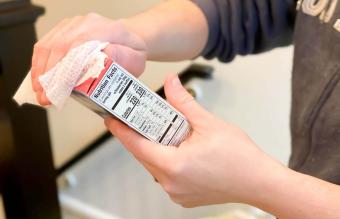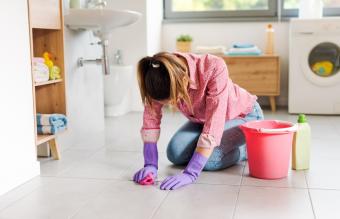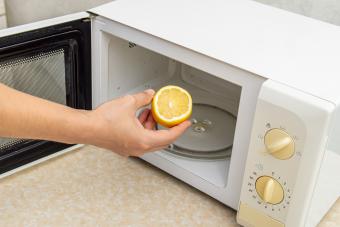
Americans are deeply concerned about contracting diseases from germs found on surfaces. Shopping for groceries is one area of concern due to the variety of surfaces and amount of people who pass through a store each day. There are steps to disinfect your groceries that can keep you and your food safe.
How to Clean and Sanitize Fresh Produce
Produce is handled by many people during the packing, unpacking and arranging of fruits and vegetables during the food transportation process. As a result, there is a fear that these foods need to be cleaned thoroughly to prevent germ transmission. However, the Federal Food & Drug Administration has stated that there is no currently known link between food and food packaging and contracting a deadly disease like COVID-19. Proper cleaning and storing your produce and groceries is more of a concern for preventing foodborne illness such as E.coli, campylobacter and salmonella.
Practicing Safe Food Handling With Produce
According to the Partnership for Food Safety Education, practicing the some core steps of safe food handling will keep you safe from foodborne illness and other potential germs. These steps include:
Step One: Clean the Food, the Kitchen and Your Hands
- Wash your hands with soap and water for at least 20 seconds before handling food.
- Wash your fruits and vegetables under running water.
- You should not use soap, even mild soap, and especially not harsh detergents on produce. Doing so can lead to accidentally ingesting chemicals that can make you very sick.
- For fruits and vegetables with firmer skin and rind, gently rub them or use a produce brush to remove any dirt.
- Pat them dry with a paper towel when you are done.
- Clean all of your cutting boards, utensils and counters thoroughly with soap and water and dry with paper towels. If you choose to use cloth towels, make sure that you launder them at least weekly.
- Wash your hands again once you are done.
Step 2: Separate the Food
- Bacteria and germs grow through cross-contamination, so it's important to keep meat separate from fresh produce.
- Do not use the same utensils and cutting boards for produce and meat without washing them thoroughly in between uses.
Step 3: Storing Produce Safely
Once you have cleaned your produce, place them in the refrigerator if they require it, or keep them in a cleaned and sanitized plastic container or a vegetable bag and at room temperature. For produce that does better in a refrigerator, make sure that the temperature is 40 degrees Fahrenheit or below and keep them in a crisper drawer if your refrigerator has one. It's important to wash your hands prior to handling and storing produce, and wash them again once you are done.
How to Clean and Sanitize Common Grocery Containers
Viruses and germs can remain viable on surfaces for some time, with longer times on porous surfaces like cardboard and paper. Some shoppers have resorted to leaving their groceries outside in a garage or enclosed porch area for 72 hours. The theory is that the virus will no longer be viable after this time. There is a much easier way to clean off containers, however.
- Remove items from grocery bags or boxes in your outside "safe" area.
- You can then wipe down individual boxes, cans, and bottles with disinfectant wipes or a spray.
- If you do not have any disinfectant, you can make your own with a mix of water and bleach. Mix 4 teaspoons of bleach with 1 quart of water in an empty spray bottle.
- Allow the disinfectant spray to sit on the surface of items for at least a minute.
- Dry them off with a paper towel before putting them away in your house inside your regular shelves or refrigerator. If you use a hand cloth to dry them off, make sure you launder it weekly.
- Do not place items that are damp away as moisture can contribute to further germ growth, especially in a dark and warm cupboard. This means any cardboard or paper items that are damp should be allowed to dry completely before being put away.
- Discard any packaging, such as plastic bags and cardboard boxes.
- Clean with disinfecting spray or soap any surfaces that the items might have touched, such as your kitchen counters.
- Once you are done, wash your hands thoroughly for at least 20 seconds with soap and water.

Dealing With Reusable Bags
Many shoppers like using reusable bags in order to protect the environment. While some stores have banned the use of bags, if your grocery store allows you to use them, you should wash them after each use. You can wash them using your washing machine and dryer and then keep the bags in your car when you're done. Finally make sure you wash your hands fully after handling the bags, such as after you've emptied them and placed them into the washing machine.
Should You Clean Grocery Containers?
While it's understandable to fear that containers you bring home from a grocery store such as bags, boxes, bottles and cans can have germs on them, there's a low risk of getting sick from touching them. According to the Centers for Disease Control, viruses like COVID-19 do not survive long on surfaces and "there is likely very low risk of spread from food products or packaging that are shipped over a period of days or weeks at ambient, refrigerated, or frozen temperatures." Transmission of germs that lead to foodborne illness is more common but can be easily eradicated simply by washing your hands before and after touching food. The biggest risk for people getting sick from their groceries comes not from touching containers or food, but from interacting with people at the store who may be infected.
If You Are In a High Risk Population
For people with underlying medical conditions and auto-immune disorders, the possibility of catching a disease such as COVID-19 or a foodborne illness like salmonella can be life-threatening. In these cases, the best course of action is to have someone else do their grocery shopping for them, or have groceries delivered, preferably with no-contact delivery. Once the food is delivered, cleaning your food items as instructed and washing your hands should keep the risk of transmission low, as the biggest risk for these individuals is being in the grocery store itself.
Staying Safe With Your Groceries
While there is no clear serious risk of catching a disease from your grocery containers, you can take some extra steps to clean them off to feel safer. Washing your produce is always a good idea but make sure you stick with water and avoid any harsh chemicals that can end up making you sick. The biggest risk for individuals with compromised health, or anyone concerned about catching a disease, is being in the grocery store around other people who may be transmitting germs and viruses. If you live in a high risk area, consider having your groceries delivered and ask for no-contact delivery.







